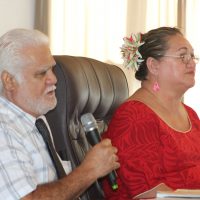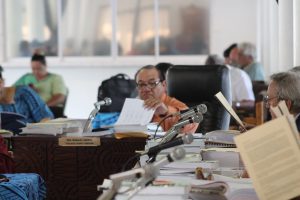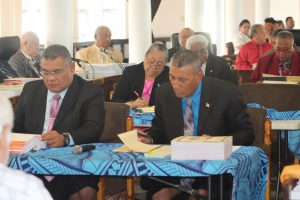
On this first day of hearings on the proposed Fiscal Year 2019 budget for the American Samoa Government, lawmakers caught what some felt was a glaring omission in the spending blue print.
The projected local revenues doesn’t include local collections earmarked to repay the American Samoa Economic Development Authority bonds.
The proposed budget for the new fiscal year totals $439.5 million of which $98.6 million is local revenues.
But that total doesn’t include the bond repayment debt which is listed under Enterprise Funds at $8 million.
House Speaker Savali Talavou Ale was persistent in his questioning of Treasurer Ueligitone Tonumaipe’a as to why the total local revenues presented in the budget plan doesn’t include the new revenues raised from increased taxes and fees that the Fono approved.
He said the budget bill must include all revenue projections even if certain revenues have been earmarked for a special purpose.
Treasurer Tonumaipe’a explained that all revenues earmarked for the bond payment are included under the Debt Service Fund which is listed under Enterprise Funds.
This money was excluded from the local revenues because it cannot be appropriated since it’s already earmarked for bond repayment.
The Debt Service Fund for FY2019 totals $8 million.
Speaker Savali repeatedly told Tonumaipe’a that regardless of whether the funds are earmarked all local revenues must be presented in full in the budget document.
Senator Tuaolo Fruean expressed the same view.
He said the Fono must be made aware of all revenues raised by the government.
Tuaolo asked Tonumaipe’a, if local revenues assigned for bond repayment falls short, what will happen then? Who will pay for the shortfall?
He said its important for the Fono to know the full amount because in the end, the Fono will be asked to approve more funding if collections for bond repayment fall short.
 Representative Vailiuama Steve Leasiolagi, co chairman of the budget hearings, told the treasurer and Budget Director Catherine Saelua that based on the General Fund report on actual collections, there should be at least $9 million added to local revenues in the FY2019 proposed budget.
Representative Vailiuama Steve Leasiolagi, co chairman of the budget hearings, told the treasurer and Budget Director Catherine Saelua that based on the General Fund report on actual collections, there should be at least $9 million added to local revenues in the FY2019 proposed budget.
He said that the revenue measures which the Fono had approved such as the 1% alternative minimum business tax, the3% hike to the miscellaneous excise tax and increased port fees and charges should raise more money than what is reflected in the budget.
Vailiuama commented that lawmakers were not popular with the public because of the revenue bills that the they passed to help fund the government.
He didn’t think those new revenues were accurately reflected in the proposed budget.
Senator Magalei Logovii observed that funding proposed for school maintenance allocated just 2.3% for materials and supplies and asked how any work can be done with such a small allocation.
Budget Director Saelua explained that materials and supplies cover just toners and office supplies,but maintenance supplies come under contractual services.
Magalei pointed out that some departments were hard pressed to fund essential services when the Budget Office cut their funding.
For example he said the Department of Public Safety didn’t have any funding for food for inmates at the Territorial Correctional Facility.
Representative Fialupe Fiaui Lutu noticed that the salaries of staff members of the Budget Office are higher in the FY2019 budget compared to the current fiscal year.
She asked if it’s just the Budget Office staff that is getting pay increments but what about other departments.
She said Fono employees haven’t received salary increments for many years.
Senator Magalei asked Saelua when the freeze on pay increments will be lifted and whether she has advised the governor to pay the increments since taxes and fees have been raised and the cost of living is climbing but workers haven’t received any pay increases.
Saelua responded that each year, pay increments for all ASG except contract workers are included in the budget but payment depends on the availability of funds.




